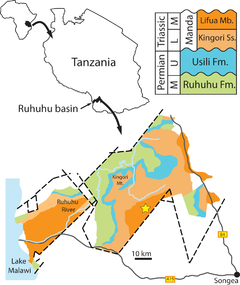| Manda Formation | |
|---|---|
| Stratigraphic range: | |
 Map of the outcropping Manda Formation | |
| Type | Geological formation |
| Unit of | Songea Group |
| Sub-units | Kingori Sandstone Member, Lifua Member |
| Underlies | None |
| Overlies | Usili Formation |
| Lithology | |
| Primary | Sandstone |
| Other | Mudstone, siltstone, marl |
| Location | |
| Coordinates | 10°18′S 35°12′E / 10.3°S 35.2°E |
| Approximate paleocoordinates | 53°42′S 23°00′E / 53.7°S 23.0°E |
| Region | Iringa & Ruvuma Regions |
| Country | |
| Extent | Ruhuhu Basin |
The Manda Formation (also known as the Manda Beds) is a Middle Triassic (Anisian?) or possibly Late Triassic (Carnian?) geologic formation in Tanzania. It preserves fossils of many terrestrial vertebrates from the Triassic, including some of the earliest dinosauromorph archosaurs.[1] The formation is often considered to be Anisian in age according to general tetrapod biochronology hypotheses and correlations to the Cynognathus Assemblage Zone of South Africa.[2] However, some recent studies cast doubt to this age, suggesting that parts deposits may actually be younger (Carnian) in age.[3][4][5]
- ^ Butler, R. J.; Barrett, P. M.; Abel, R. L.; Gower, D. J. (2009). "A possible ctenosauriscid archosaur from the Middle Triassic Manda Beds of Tanzania". Journal of Vertebrate Paleontology. 29 (4): 1022–1031. Bibcode:2009JVPal..29.1022B. doi:10.1671/039.029.0404. S2CID 86267617.
- ^ Cite error: The named reference
Nyasasauruswas invoked but never defined (see the help page). - ^ Nesbitt, S; Butler, R; Ezcurra, M; Charig, A; Barrett, P (2020-07-08). "The anatomy of Teleocrater rhadinus, an early avemetatarsalian from the lower portion of the Lifua Member of the Manda Beds (Middle Triassic) (project)". MorphoBank datasets. doi:10.7934/p3173. S2CID 226195075. Retrieved 2021-11-25.
- ^ Marsicano, Claudia A.; Irmis, Randall B.; Mancuso, Adriana C.; Mundil, Roland; Chemale, Farid (2015-12-07). "The precise temporal calibration of dinosaur origins". Proceedings of the National Academy of Sciences. 113 (3): 509–513. doi:10.1073/pnas.1512541112. ISSN 0027-8424. PMC 4725541. PMID 26644579.
- ^ Ottone, Eduardo G.; Monti, Mariana; Marsicano, Claudia A.; de la Fuente, Marcelo S.; Naipauer, Maximiliano; Armstrong, Richard; Mancuso, Adriana C. (December 2014). "A new Late Triassic age for the Puesto Viejo Group (San Rafael depocenter, Argentina): SHRIMP U–Pb zircon dating and biostratigraphic correlations across southern Gondwana". Journal of South American Earth Sciences. 56: 186–199. Bibcode:2014JSAES..56..186O. doi:10.1016/j.jsames.2014.08.008. hdl:11336/85022. ISSN 0895-9811.
